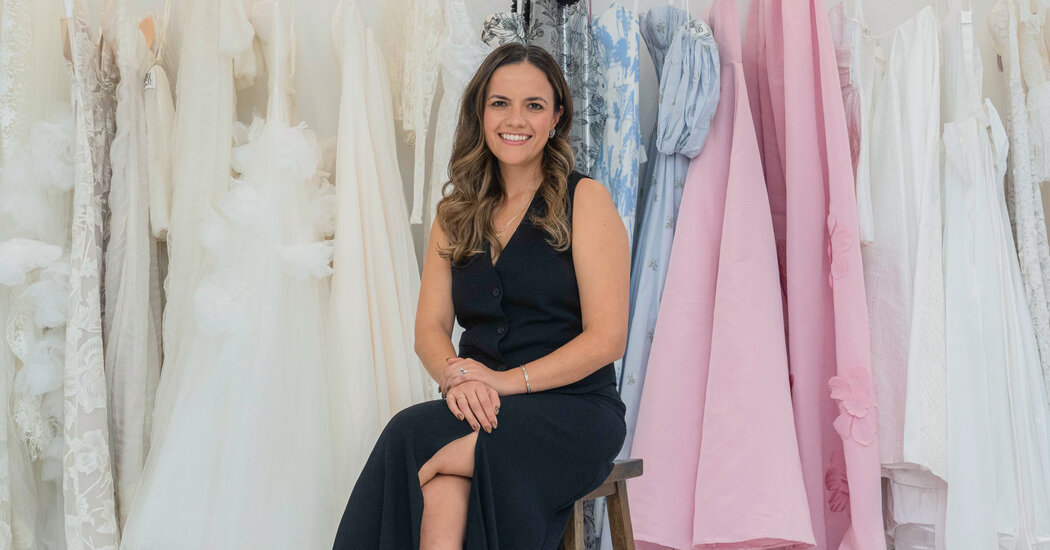
From Sept. 27 through Oct. 16, Nadia Manjarrez, a bridal designer born and based in Mexico, will endure a marathon of sorts around New York Bridal Fashion Week, which takes place from Oct. 10 through 12. Her race includes leading a three-day fashion industry workshop with students from Mexico’s Istituto di Moda Burgo; a photo shoot of her 2024 fall collection; model fittings; inaugurating her New York showroom (one of the first for a woman bridal designer from Mexico); and organizing in-person appointments with buyers and brides.
“This is a before and after moment,” said Ms. Manjarrez, 34, who arrived in New York in 2011 when she was 21, and immediately started working for designers like Bibhu Mohapatra, Badgley Mischka, Flor et.al, and Marchesa. “I’ve been creating these big shoes, which are my dreams, and what I’ve envisioned for my brand and career. Now I need to fill them and prove myself.”
Ms. Manjarrez started her career focusing on evening wear, then slowly edged her way into bridal. “Bridal is full of emotion and story,” she said.
In December 2019, she became immersed in wedding gowns when six different friends and relatives asked her to design their dresses. She headed home to Culicán, Mexico, to complete the work. Then came the pandemic, followed by her father’s death from Covid in January 2021. Devastated by the unexpected loss, and realizing she wanting to do something more impactful with her life, she started her own company a week later, Nadia Manjarrez Bridal.
Ms. Manjarrez spoke with The New York Times from her studio and factory in her hometown to discuss her newest collection and her culture.
The interview has been lightly edited and condensed for clarity.
How did your father’s death ignite your career in bridal design?
I left Mexico when I was 16. When I came home, I learned as an adult who my father was. When he died, I didn’t know what to do. It was therapy for me to start my own collection. I insisted I would have a line to show in October 2021 and gave myself seven months to create 13 pieces. I printed a one-year calendar and gave myself goal dates. I hired bridal seamstresses. The six brides I was working with before the pandemic were my focus group.
What did you learn from that group?
Brides want lightweight fabrics. They want simple but dramatic designs and versatility. One dress became two: one for the ceremony, one for the parties. I created long, dramatic, detachable embroidered trains, so big ball gowns could become short cocktail dresses. I made sleeves removable and added hidden straps, so brides could dance.
How is your Mexican culture reflected in your work?
Most Mexican brides get married in Catholic churches. Mexican culture is seen through embroideries, embellishments; big, dramatic entrances on the way to the altar; and flowers. I focused on these elements. I’m not going after the minimalistic bride.
Your collection for spring 2024 was inspired by women who changed the course of Mexican history.
I wanted to highlight women who shaped the Mexican feminist culture. I included Adela Velarde Pérez, for example, the first woman to join the Mexican army during the revolution. She had a particular way of wearing ammunition crisscross around her chest. I drew inspiration from that shape and turned it into the top of one of our dresses and combined that with lace, making it romantic. The other women were Frida Kahlo, La Malinche, Sor Juana Inés de la Cruz and the palenqueras, or the women who work in a palenque, which is a mezcal distillery in Oaxaca.
Your latest collection for next fall is also a tribute to your heritage. How?
The inspiration was contemporary Mexican stained-glass church windows, and the Mexican version of our Virgin Mary, called Guadalupe. This collection includes the color dusty pink, an important shade in our stained-glass. We also used brocades and jacquard, types of weaves that use metallic thread and add shine, and embroidered black thread inspired from the black piping around the glass windows.
As a young Mexican woman, was it hard to break into this market?
It’s only recently that Mexican designers are chasing the American bridal market. In Mexico, women are self-taught and learn as they go. Because of that, they work for themselves instead of others. Opportunities are limited, or they don’t exist.
If I hadn’t spent 12 years of my life in New York, which gave me fantastic training and opened doors for me, then I wouldn’t be where I am. It was hard to prove I belonged. I didn’t see anyone else that looked like me or had my background working in the design space. That made me work harder.
What have you learned from working so closely with brides?
Every bride’s story is different and they want to weave their story and their background into what they’re wearing. By designing their dress and how it looks on them, I’m helping to tell their story. And that’s humbling.






